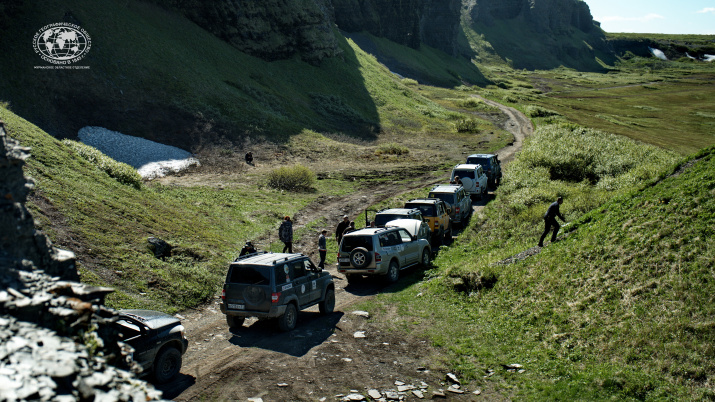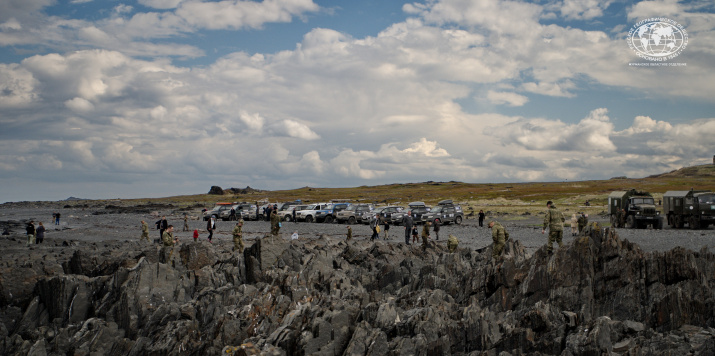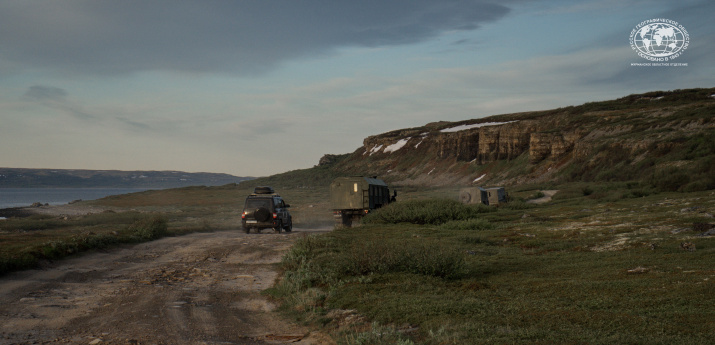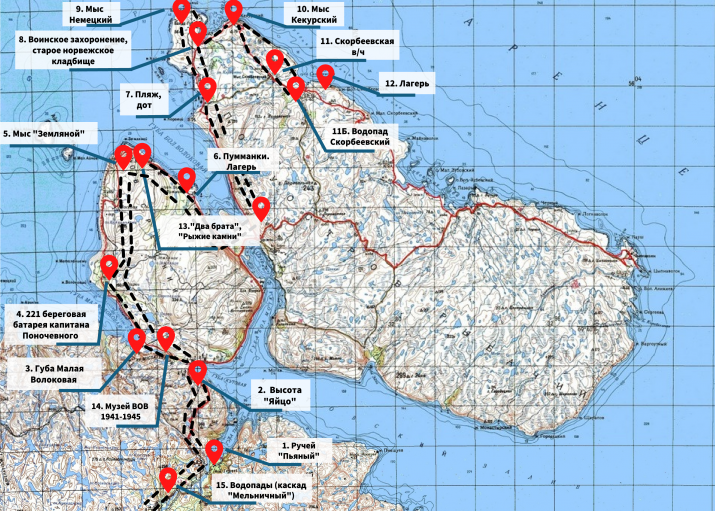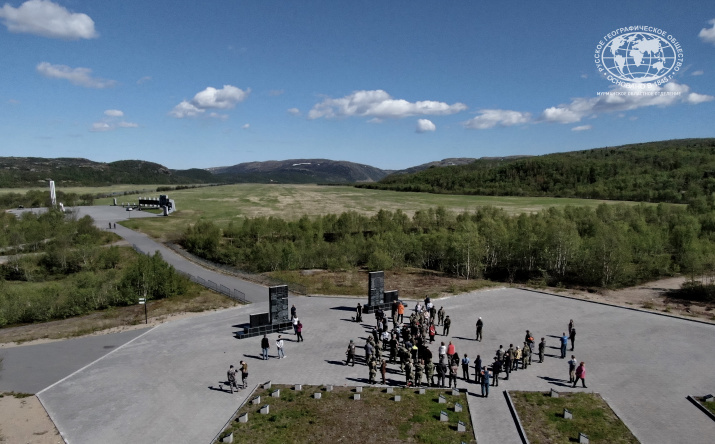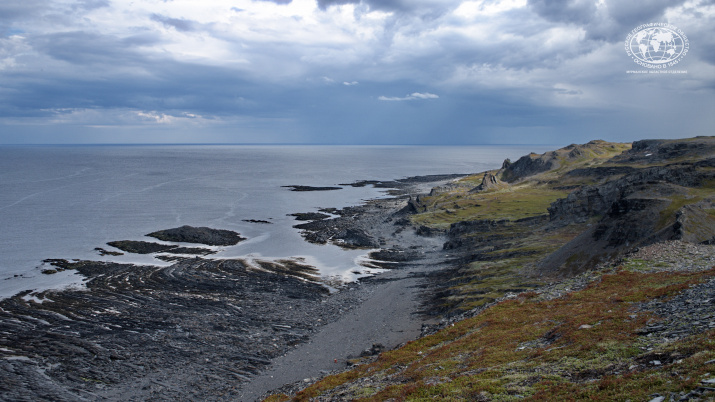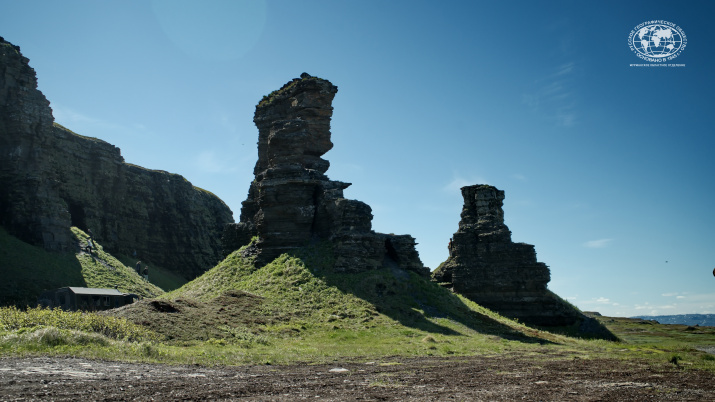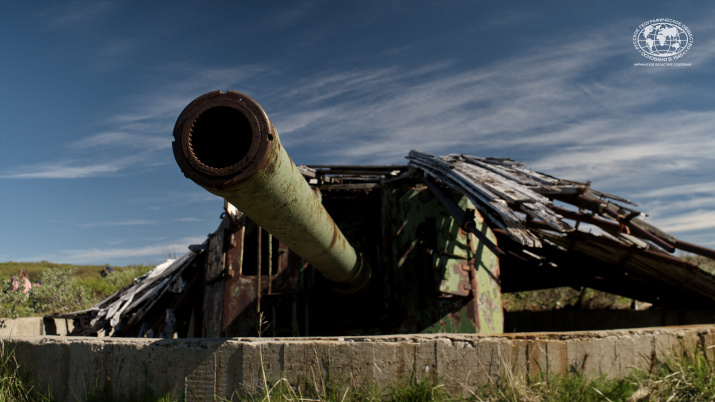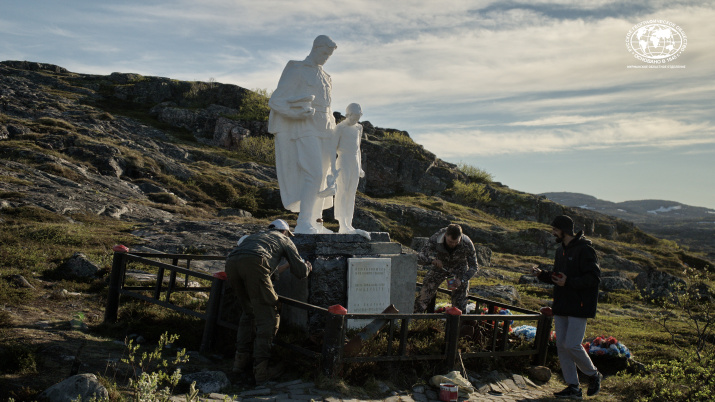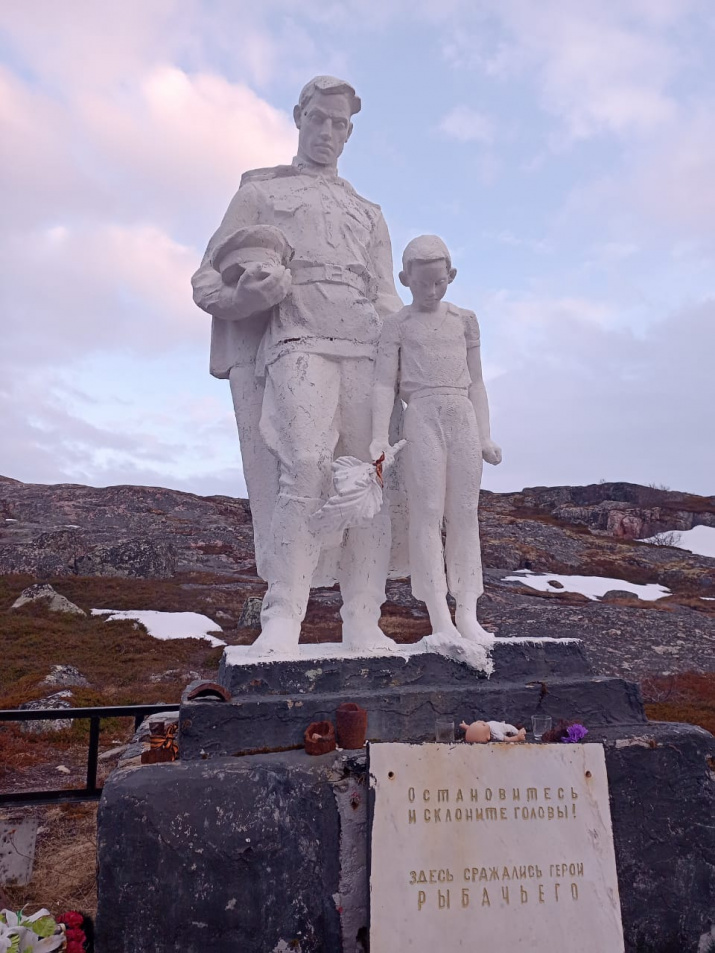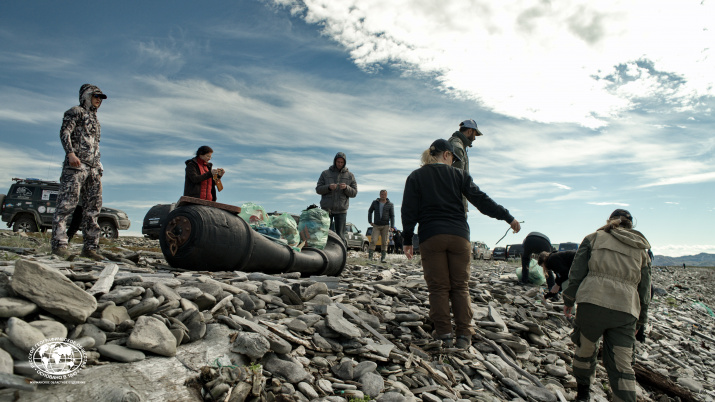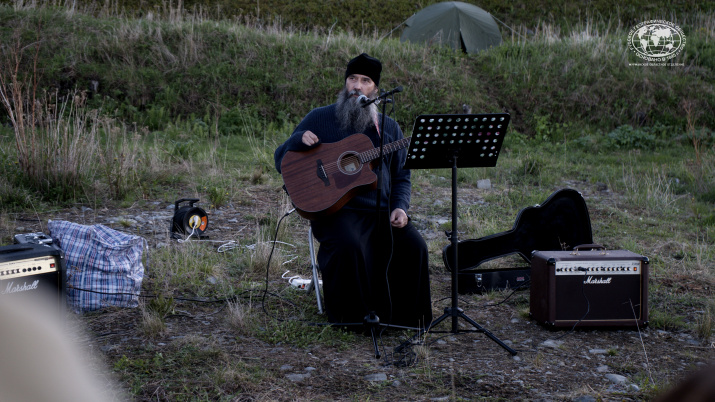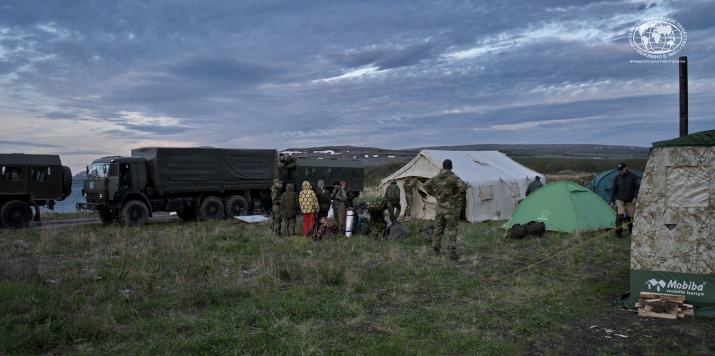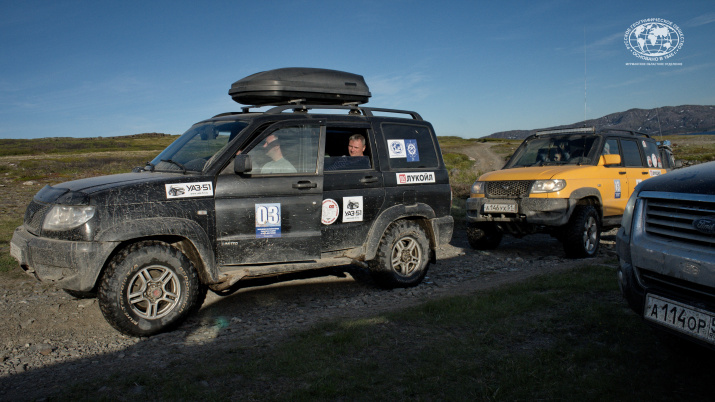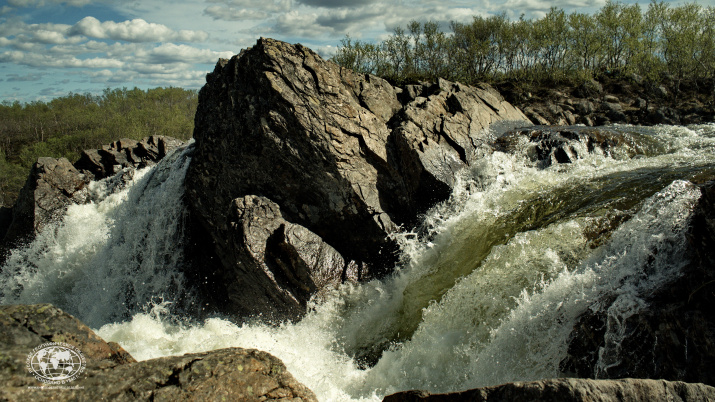June 11 through 13, 2022, a joint multidisciplinary expedition of the Murmansk Regional Branch of the Russian Geographical Society (MRB RGS), one of the units of the 12th Main Directorate of the Ministry of Defense (12 GU MO) of the Russian Federation, the “Patriots of Murmansk 4x4” club and the Park-Hotel “Expedition” took place. The expedition's route passed through the Sredny and Rybachy peninsulas. This territory is extremely important for the history and geography of Russia. The expedition was timed to Russia Day, as well as to two important dates of the 2022: the 75th anniversary of the Murmansk Regional Branch of the RGS and the 75th anniversary of the 12th Main Directorate of the Ministry of Defense of the Russian Federation.
The expedition had a whole range of diverse tasks: the study of coastal Arctic ecosystems, environmental and local history education, restoration of the Great Patriotic War monuments and survey of burial sites of those who fell defending the Arctic. In addition, it worked out military-historical and cultural-historical tourist routes around the peninsulas. The participants of the expedition got acquainted with the unique nature and history of the peninsulas. The expedition was also dedicated to the celebration of Russia Day at the northernmost continental point of the European part of Russia.
“We are indeed not going to the North Pole, we are not conquering the unexplored expanses of Africa or the tundra, we are not going all the way to Antarctica. Nevertheless, this is a very important and organizationally complex event. Many different establishments and people were engaged in the preparation,” said Sergey Goncharov, the head of the expedition and a member of the MRB RGS Council.
The expedition, supported by the Government of the Murmansk Region and the leadership of the Ministry of Defense, was outstanding not only because of the variety of tasks being solved, but also because of the number of participants. The expedition's convoy consisted of 14 passenger SUVs and 3 army trucks. In total, more than a hundred people took part in the expedition. Those were MRB RGS members, military personnel of the 12th GU MO and Young Army сadets, rescuers of the Unified Duty Dispatch Service, scientists of the MMBI RAS, representatives of the "Patriots of Murmansk 4x4" club, the National Guard of the Russian Federation, PJSC Lukoil Oil Company, Avtogur73 Сompany, National Enterprise of the Small Peoples of the North "Pessyaryok", the Severomorsk Diocese, employees of the Park-Hotel “Expedition”, journalists of the State television and radio company “Murman”, TV company “TV-21”, production company KolaFornia, professional photographers and videographers. The route of the expedition covered about 400 km of extremely difficult roads. At the same time, strict rules were observed on the route to ensure the safety of participants and the fragile nature of the peninsulas.
The first point of the route was the Valley of Glory. It was here in 1941 that the rapid advance of the Nazi troops invading Murmansk was stopped.
Then, after passing the cascade of waterfalls “Melnichny”, the expedition members crossed the Musta Tunturi pass. Murmansk local historian Mikhail Oresheta accurately called it the “granite battleship" for its role in the defeat of the fascists. Then the convoy passed along the western coast of the Sredny Peninsula, along the Malaya Volokovaya and Bolshaya Volokovaya bays. The camp was set up in the Pummanki area. The next day, the groups divided according to the tasks assigned to each. The task of the first and bigger group was to reach Cape Nemetsky, the northernmost point of the continental part of European Russia. There, only the open water of the Barents Sea and the Arctic Ocean separated the expedition participants were from the North Pole. In the future, it is planned to install a sign “Russia begins here" on the Cape Nemetsky, so the expedition had to look for the best place for this sign. The second group was tasked with reaching Zubovskaya Bay and collecting data about petroglyphs located there. They are one of the oldest petroglyphs in Northern Europe, but there is very little information about them. Apart from that, the expedition examined Cape Kekursky, a place of unique beauty and the trademark of the Rybachy Peninsula, “Two Brothers”, thirty-meter-high buttes standing apart from the plateau, Red Rocks, Skorbeevsky Waterfall and other unique natural attractions of the Sredny and Rybachy peninsulas.
In the route there also was a significant number of historical monuments. Among them was the legendary Ponochevny's 221 coastal battery that fought heroically during the Great Patriotic War.
One of the main activity areas of the Murmansk Regional Branch of the RGS in general and one of the central tasks of this expedition is to preserve the memory of the fallen defenders of the Fatherland. The Rybachy and Sredny Peninsulas are almost a real open-air museum. During the war, it was the territory of an extremely tense confrontation between the defenders of the Soviet Arctic and the Fascist invaders. The defense lasted about 1200 days with varying success. The enemy was never able to advance to the eastern part of the peninsulas.
During the expedition, the participants restored a landmark memorial to the Heroes of Rybachy, dedicated to the people who defended this land. The base crumbled, the plaster statue cracked, the fastenings of the marble slab rotted and collapsed causing it to fall and split.
Using cement mortar, the expedition members repaired the monument, dried it and painted it with fresh paint, took the garbage out and removed old wreaths and plastic flowers. They fixed the slab, cleaned it and put in place, then they neatly laid out iron fragments from the war by the monument.
The main scientific tasks of the expedition were to assess the species diversity of coastal ecosystems, as well as to monitor marine debris on the coasts of peninsulas.
The task of studying the bioresources of this territory is fundamental and application-oriented at the same time. There are many species in the Arctic that only occur during warm climatic cycles. In the south-west of the Barents Sea, the influence of warm currents is much stronger, so this area is a good place to conduct research on the littoral zone, approximately four meters of which is exposed during low tides.
The second task was related to environmental protection. The sea coasts of the Rybachy and Sredny peninsulas, which are a specially protected natural territory, accumulate a large amount of international marine debris, including long-decomposing plastic.
“Plastic and marine debris are a huge problem. Waste on the coasts is just the “tip of the iceberg". Most of the marine debris is concentrated on the seabed, and no one undertakes to estimate how much of it there is,” said Svetlana Malavenda, Candidate of Biological Sciences, Senior researcher at the MMBI RAS.
The analysis of pollution of beaches was carried out according to the international methodology provided by the MMBI RAS. It was used as part of the Russian-Norwegian MALINOR project. The methodology is used in studies of the main directions of waste accumulation and distribution along the coasts of Norway and Russia, as well as in the description and mapping of polluted coastal areas of the Norwegian, Barents and other Arctic seas.
According to this method, you have to mark a ten-by-ten-meter piece of land from the upper border of the littoral zone, then collect and sort the waste by type and size. Three categories of waste were taken into account at each site: plastic, glass and iron. In addition to monitoring itself, there was another important task during the expedition. It was to teach people this method in order to be able to collect more scientific material in the future.
On June 12, Russia Day, a festive concert was held. It was organized with the participation of the priests of the Severomorsk Diocese, Father Sergiy Sherfetdinov and Father Leonid Suloev. Father Sergiy Sherfetdinov, Archpriest, rector of the parish of St. Nicholas the Wonderworker of the village of Vidyaevo and the parish of the Mother of God's icon 'The Joy of All Mourners'” of the village of Ura-Guba, performed songs from his creative program “For one's friends".
A number of public, state and commercial organizations took an active part in the preparation of the expedition under the flag of the Russian Geographical Society.
The leadership of the 12th Main Directorate of the Ministry of Defense (12 GU MO) of the Russian Federation ensured an active participation of military personnel in the expedition. Among other tasks, they were engaged in the restoration of military monuments, as well as in setting up the camp and providing hot meals.
The "Patriots of Murmansk 4x4" club was the main driving force of the expedition, which involved 14 club SUVs. In addition, the club members took an active part in the preparation of the route. There were two reconnaissance trips before the expedition which made it possible to adjust the route in accordance with security considerations.
The initiative of the MRB RGS was supported by the Russian oil company Lukoil, which became the fuel sponsor of the event and provided all civilian vehicles participating in the expedition with fuel throughout the route.
The Park-Hotel “Expedition” that hosts the Murmansk Expedition Center of the Russian Geographical Society, established in 2020, has provided substantial support in organizing the expedition, holding related events, and also took over the provision of dry rations for the expedition.
The Unified Duty and Dispatch Service, consisting of a group of 4 people with equipment and medicines, provided the medical and rescue support.
Directorate of Protected Areas has allowed to conduct an expedition in the territory of the nature park of regional significance “Rybachy and Sredny Peninsulas".
The staff of the recreation center “Kitovy Bereg” restored two monuments to the reconnaissance groups of Yunevich and Vishnyakov. After the expedition, it was decided that they would take permanent patronage over them. They also assisted in the purchase of fuel for a reconnaissance trip in early June 2022.
The Murmansk Regional Branch of the Russian Geographical Society expresses its gratitude to all partners and participants of the expedition.


